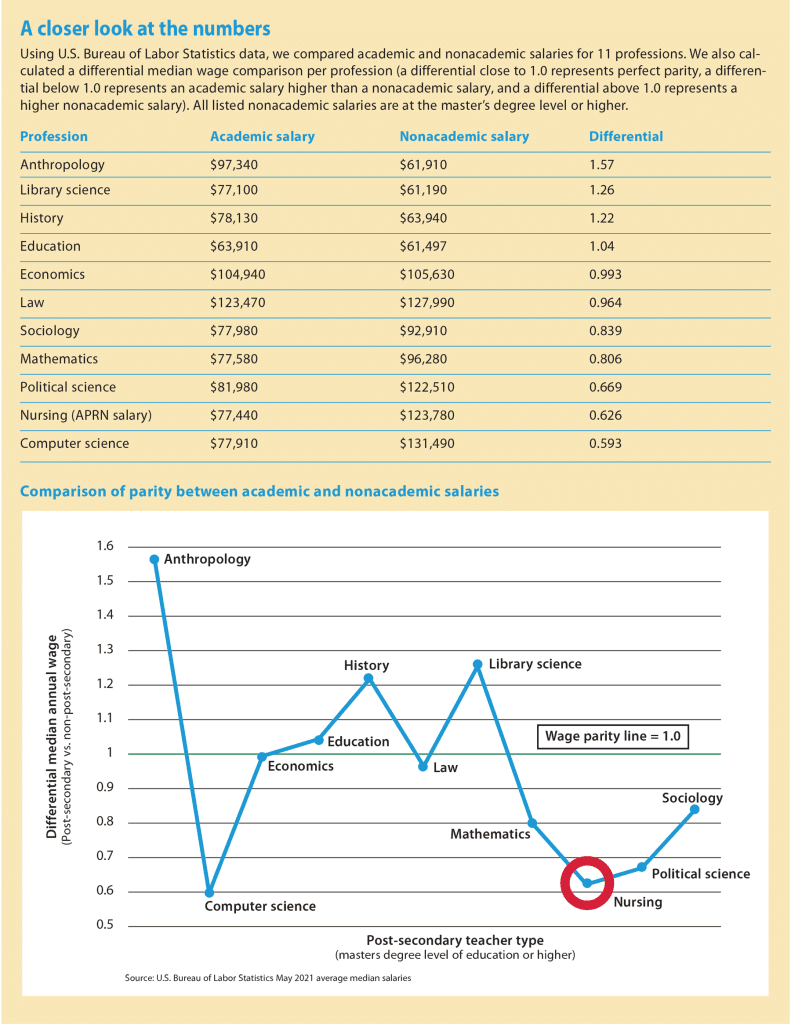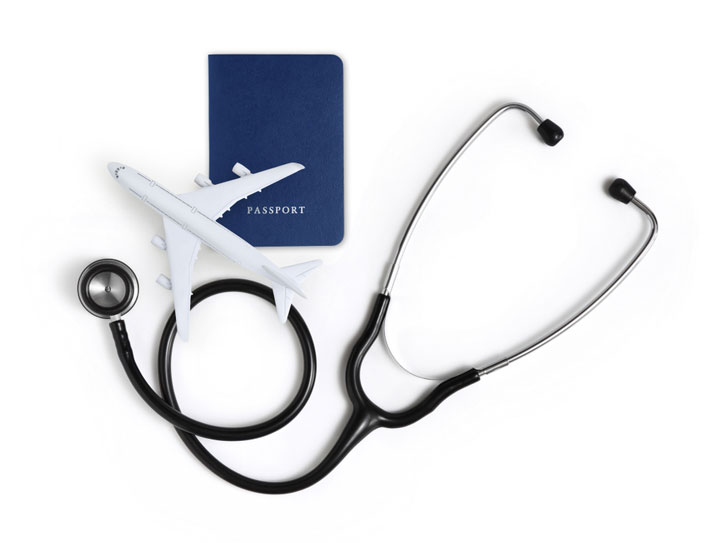- The nurse faculty shortage must be addressed to meet the healthcare needs of the public.
- The salary gap between academic nurse educators and clinical practice nurses likely contributes to the nurse faculty shortage.
- Additional investments are necessary to recruit and retain sufficient nursing faculty.
Several challenges and barriers have led to the faculty shortage, but low salaries may be the driving force behind recruitment struggles, faculty dissatisfaction, and plans to leave academia. Many faculty positions require a graduate or terminal degree, which some nurses may find financially burdensome, whereas RNs and advanced nurse practitioners (APRNs) in clinical roles earn more. Although an academic nursing career has many benefits, including schedule flexibility and the opportunity to make an impact on future nurses, such benefits may be insufficient to rationalize the salary gap between the clinical and faculty nursing roles.
Goolsbee and Syverson describe economic monopsony (a limited pool of employers for a given profession) as a market force that drives down academic faculty salaries and therefore influences poor faculty–clinical salary parity. Some other academic disciplines have similar discordance between industry and academic salaries, but a unique urgency exists in nursing to address the inadequate supply of nurse faculty because of the significant downstream implications on the clinical nursing workforce.
Exploring the magnitude of the academic faculty–industry salary disparities that exist across different disciplines may help us better understand the situation in nursing and aid the development of strategies to address it.
What we did
We obtained median postsecondary teacher salaries, by industry, from the Bureau of Labor Statistics Occupational Outlook Handbook for postsecondary teachers in 35 unique categories, including nursing. Each group breaks down further into industry subgroups. We selected industries for comparison between academic and nonacademic settings when both groups have median salary data available for those with a master’s degree or higher. For nursing, we compared APRN industry salaries to faculty salaries because APRN positions require at least a master’s degree.
We calculated a differential median wage comparison per industry. The numerator for each differential is the academic median salary and the denominator is the median nonacademic salary. A differential close to 1.0 represents perfect parity between academic and nonacademic salaries for a given industry. A differential below 1.0 represents an academic salary higher than a nonacademic salary, and a differential above 1.0 represents a higher nonacademic salary.
What we learned
According to the Bureau of Labor Statistics (BLS) data, the median annual faculty salary across all industries is $79,640. The median annual nurse faculty salary ($77,440) is $2,200 lower than the overall median faculty salary. The nursing industry median salary equivalent for an APRN ($123,789) is $46,349 higher than the nurse faculty median. Among the salaries of the 35 postsecondary teacher subcategories reported by the BLS, nursing ranked 27th.
We matched (based on a minimum education at master’s level or higher) a nonacademic labor category for 11 industries. Nursing ranked ninth among academic salaries and second for nonacademic salaries. In addition, nursing had the second lowest salary parity differential (0.626) between academic and nonacademic roles. (See A closer look at the numbers.)
Nursing faculty are a highly educated group who frequently contend with the pressures of promotion and tenure requirements in addition to their teaching and service duties. However, many nurse faculty receive less compensation than the nurses they’re tasked with preparing for the profession.
APRNs possess education levels comparable to postsecondary nurse educators and enjoy a median compensation rate 35% greater than nurse faculty. Our analysis indicates that, compared to other professions, nursing is an outlier with regards to salary parity between academic and nonacademic positions. Such a large salary disparity may dissuade master’s-prepared nurses from choosing faculty roles.
What nursing should do
Executive leadership in colleges and universities must do more to close the salary gap for nursing faculty. However, academia may not be able to tackle the $46,349 median gap (per nurse faculty). Nurse faculty must partner with academic leadership to redirect existing government funding to help close this gap. In 2021, the federal government appropriated nearly $500 million to support the nursing workforce. However, none of those funds were allocated to the salaries needed to retain educators. Policymakers must also consider strategies for providing direct capital to support nurse faculty salaries. Senate Bill S.2815 and House Bill H.R. 7002, the Nurse Faculty Shortage Reduction Act, represents policy aimed at providing a federal wage differential to support new nursing school faculty members.
In addition to fostering more targeted advocacy, the nursing profession needs to better understand the causes behind the salary disparity. Do different market forces exist for nurses with advanced degrees, and do those differences influence individual choices to work in academic vs. nonacademic settings? Although you can find robust literature on academic vs. nonacademic salaries in general, little of that literature addresses the unique market conditions that affect nurses with advanced degrees. Most of the literature focuses on the economic theory that colleges and universities operate as monopsonies, where academic institutions serve as the sole purchaser of faculty labor. Limited literature examines specific academic disciplines, particularly disciplines like nursing, where nonacademic opportunities remain plentiful.
Economic intuition suggests that supply-side organizations may play a significant role in addressing the nurse faculty shortage. Colleges and universities have significant monopsony power over tenure-track faculty, as academia may operate as a wage-setter for nurse faculty rather than a wage-taker (that is, academic institutions serve as the primary buyers of nursing faculty labor, so they have disproportionate economic power to set nurse faculty wages). More research can help us understand how the dynamics of academic tenure and nontenure track positions affect the nursing faculty shortage.
Research results support the monopsonistic tendencies of healthcare systems as it pertains to the nursing workforce. Consolidated healthcare systems also operate as wage-setters by fixing wages for advanced practice nurses. In effect, nurses with advanced degrees can sell their labor to several monopsonic dynamics—academia and large consolidated healthcare systems. The dueling monopsonies may affect supply-side behaviors to suppress nurse faculty supply. We need to better understand these market forces and how they affect supply-side nursing economics. However, publicly available nurse faculty labor data are limited and further research most likely can be obtained only through an independent survey of nurse faculty.
The implications and limitations
The stability of the nursing profession relies on the promotion of postsecondary nursing education as a reasonable career option. Nursing faculty educate tomorrow’s nursing workforce, but the faculty shortage jeopardizes timely education. Financial support exists for nurses who pursue graduate degrees to become postsecondary nurse educators, but it may be insufficient to fully address the shortage. Examples include the U.S. Health Resources and Services Administration Faculty Loan Repayment Program and state programs, like the Wisconsin Nurse Educator Program, to provide loan forgiveness to future nurse faculty who agree to teach in the state after graduation. However, the use and impact of such programs on the faculty shortage remain unclear due to a lack of documentation of their recruitment efficacy and the additional barriers to nursing faculty careers.
The median nursing faculty salary reflects those educators with a master’s degree or higher. Although some educators in the sample may include those with degrees below the level of master’s, the BLS definition indicates that this is uncommon and the American Association of Colleges of Nursing reported that 84.9% of vacant positions preferred a doctoral degree.
The closest publicly available comparison group for the nonacademic nursing salary was for those practicing as nurse midwives, nurse practitioners, and nurse anesthetists. However, not all master’s-prepared nurses work in advanced practice roles. As such, the reported median salary of $123,780 likely skews high for comparison purposes. Additional research can help estimate the percentage of nursing educators teaching with master’s degrees, master’s degrees with postsecondary certificates, advanced practice certification, and PhDs, as well as the median salary for each group.
Addressing the nursing faculty shortage requires answers to several questions: Is the primary issue truly the cost of postsecondary education, or is lack of opportunity for financial advancement upon entering postsecondary education an underrecognized barrier? Are barriers different for postsecondary nurse faculty who belong to an underprivileged group? Are barriers to seeking nurse faculty positions different for full-time and part-time faculty? The answers to these questions will better inform methods of attracting and retaining nurse faculty, but such data aren’t available.
Attention and investment
Nurse faculty recruitment and retention are vital to addressing the U.S. nursing shortage. However, the ongoing shortage of nurse faculty is projected to worsen. Without sufficient nurse faculty, higher education systems will be unable to educate nurses to meet the healthcare needs of the American public. Solving this issue requires careful attention and additional investments.
The authors work at Marquette University College of Nursing in Milwaukee, Wisconsin. Jacqueline Christianson is an assistant professor, Jessica Zemlak is an assistant professor, Kathryn Malin is an assistant professor, and Lisa Grabert is a visiting research professor.
American Nurse Journal. 2024; 19(6). Doi: 10.51256/ANJ0624122
References
118th Congress. S.2815 – Nurse Faculty Shortage Reduction Act of 2023. Published 2023. Retrieved from: https://www.congress.gov/bill/118th-congress/senate-bill/2815/history?s=1&r=1
118th Congress. H.R. 7002 – Nurse Faculty Shortage Reduction Act of 2024. Published 2023. https://www.congress.gov/bill/118th-congress/house-bill/7002
American Association of Colleges of Nursing. Nursing shortage fact sheet. October 2022. bit.ly/3PcOZuD
American Association of Colleges of Nursing. Data spotlight: Regional analysis of qualifed application denied admission. April 26, 2022. aacnnursing.org/news-data/all-news/article/data-spotlight-regional-analysis-of-qualified-application-denied-admission
Boamah SA, Callen M, Cruz E. Nursing faculty shortage in Canada: A scoping review of contributing factors. Nurs Outlook. 2021;69(4):574-88. doi:10.1016/j.outlook.2021.01.018
Bowden VR, Schmus C. Predictable consequences—How do we avert a pediatric nursing shortage? Pediatr Nurs. 2021;47(1):5-6.
Christianson J, Johnson N, Nelson A, Singh M. Work-related burnout, compassion fatigue, and nurse intention to leave the profession during COVID-19. Nurse Lead. 2023;21(2):244-51. doi:10.1016/j.mnl.2022.06.007
Goolsbee A, Syverson C. Monopsony power in higher education: A tale of two tracks. Working Paper 26070. National Bureau of Economic Research. July 2019. nber.org/system/files/working_papers/w26070/w26070.pdf
Hirsch BT, Schumacher EJ. Monopsony power and relative wages in the labor market for nurses. J Health Econ. 1995;14(4):443-76. doi:10.1016/0167-6296(95)00013-8
Staiger DO, Spetz J, Phibbs CS. Is there monopsony in the labor market? Evidence from a natural experiment. J Labor Econ. 2010;28(2):211-36.
Tubbs-Cooley HL, Mara CA, Carle A, Mark BA, Pickler RH. Association of nurse workload with missed nursing care in the neonatal intensive care unit. JAMA Pediatr. 2019; 173(1):44-51. doi:10.1001/jamapediatrics.2018.3619
U.S. Bureau of Labor Statistics. Occupational employment and wages, May 2022: Registered nurses. www.bls.gov/oes/current/oes291141.htm
U.S. Bureau of Labor Statistics. Occupational outlook handbook: Nurse anethetists, nurse midwives, and nurse practitioners. September 6, 2023. www.bls.gov/ooh/healthcare/nurse-anesthetists-nurse-midwives-and-nurse-practitioners.htm
U.S. Bureau of Labor Statistics. Occupational outlook handbook: Postsecondary teachers. September 6, 2023. www.bls.gov/ooh/education-training-and-library/postsecondary-teachers.htm#tab-5
U.S. Bureau of Labor Statistics. Registered nurses. April 25, 2023. https://www.bls.gov/oes/current/oes291141.htm
U.S Department of Health & Human Services Health Resources and Services Administration. Report to Congress: Nursing Workforce Report. 2021. bhw.hrsa.gov/sites/default/files/bureau-health-workforce/about-us/reports-to-congress/Nursing-Workforce-RTC-FY-2021-508.pdf
Key words: nurse faculty, nurse educators, nurse faculty shortage, salaries, fringe benefits



















